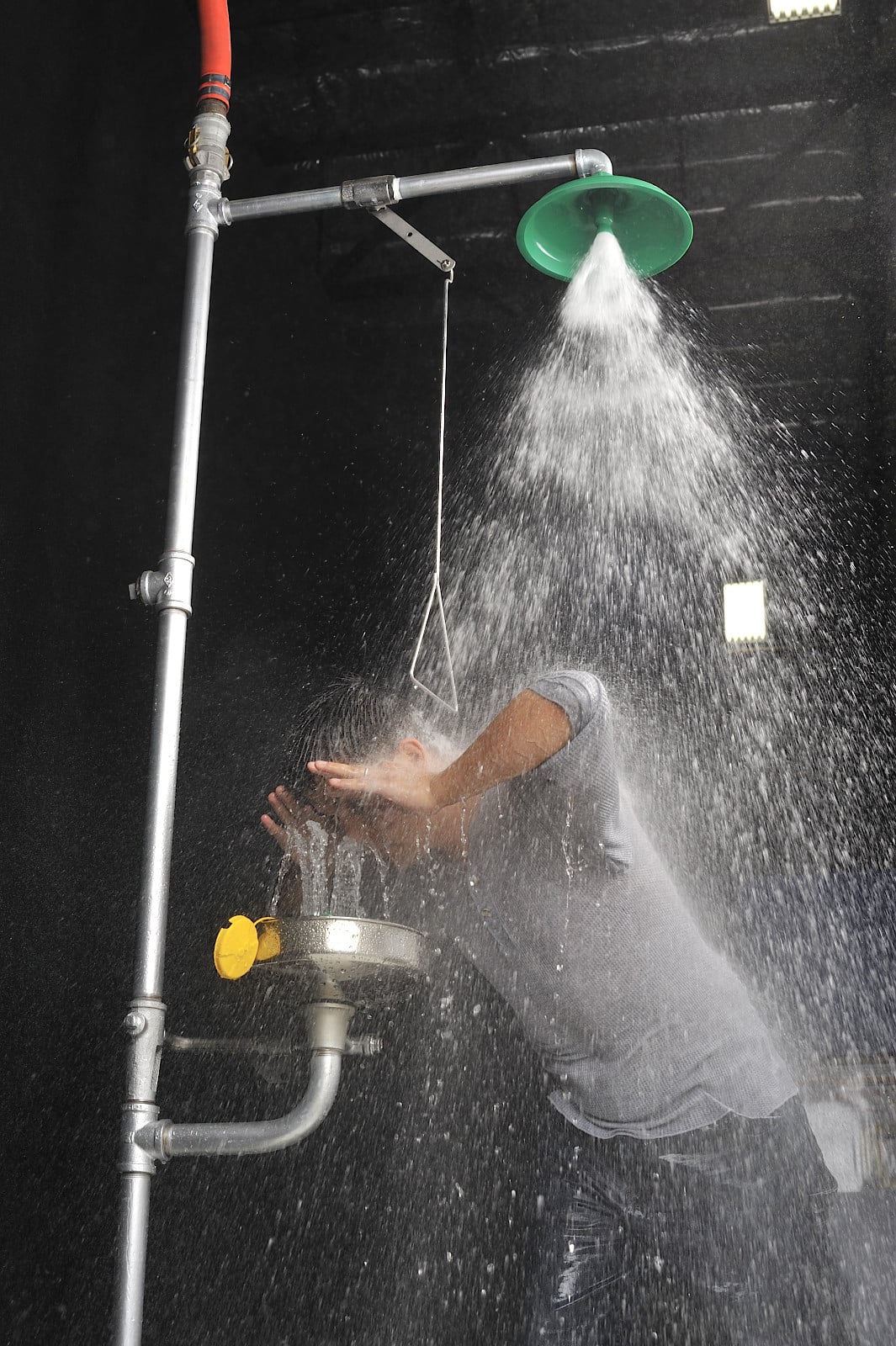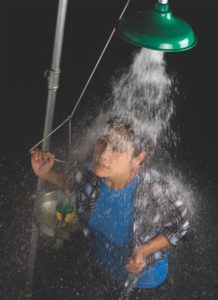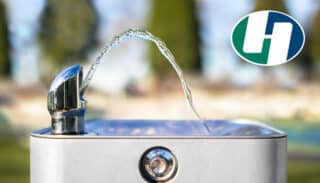Below are some frequently asked questions regarding the ANSI Z358.1-2014 requirement of providing tepid water for emergency showers & eyewashes. Tepid water is defined as flushing fluid between 60°F- 100°F (16°C- 38°C).
If the area is typically 70°F (21°C), is the use of a 300 gallon storage tank an acceptable means of providing tepid water for emergency showers & eyewashes?
Yes and no. Theoretically you could fill a tank without an immersion heater and allow it to reach equilibrium with the ambient environment (70°F [21°C]), and provide tepid water. The issue is that you will need more water than 300 gallons to provide 15 minutes of tepid water because you will have to account for the shower (20 gpm) and eyewash (1 gpm) or eye/face wash (3-5 gpm depending on manufacturer). Based on these, you will require as a minimum 315 gal at a minimum assuming 100% usage for a shower/eyewash or 345 gal minimum assuming 100% for a shower and eye/face wash combination. If this is a self-contained unit, you could do this but would have to add a bacteriostatic solution, have at a minimum a 400 gal tank, and some means for delivering the water (air cylinders or pump). Haws Integrated can provide a plug and play system of this type.
The other thing to consider is that you are now holding water at a temperature that is much more prone to bacterial growth. When Haws Integrated designs a tepid water system, we will hold the water at a minimum of 145°F (62.8°C), but more typically at 165°F (73.9°C), which prevents the growth of bacteria. Also critical to eliminating bacterial growth is the flushing of the showers and piping on a weekly basis. Without a heater, the recovery time could be significant.
If you have cold water plumbing and adequate pressure, then I would recommend that you use a hot water tank system along with a mixing valve to get tepid water for a potable water system.
How do you provide cool water for tempering valves? (e.g. cooling tower water exchanger, air finned cooler, etc?)
The cool water comes from the potable water supply, and is assumed to be below 60°F (16°C). The water will be combined with the hot water in the storage tank to produce tepid water for emergency showers & eyewashes.
My facility uses 65°F (18.3°C) as the low end temperature for Legionella growth and requires mixing valve to pass 160°F (71°C) for shock treatment of tepid systems, but you recommended 80-85°F (26.7-29.4°C)?
Legionella growth range is between 68°F – 122°F (20-50°C). Most potable water coming into a tepid water system is below 60°F (16°C). On the hot water side the water is held at 165°F (73.9°C) or above, therefore lowering the possibility of Legionella growth. There is no mixing valve on the market designed for safety showers that can pass water at 165°F (73.9°C) for shock purposes. This is a dangerous scenario for safety equipment. A process would need to be implemented to ensure the safety equipment could not be used until the piping temperature was reduced to below 100°F (38°C).
ANSI Z358.1 – 2004 code, clause B6 suggested 60°F (16°C) tepid water is suitable as the lower limit of tepid water. Is there a change of concept between 2004 and 2014?
No, there is no change in the tepid water requirement. However, the 2009 and 2014 standards moved the tepid water ranges of 60°F to 100°F (16°C- 38°C) from the appendix to the main section of the standard. We recommend that the temperature be in the middle of the range for user comfort and promoting 15 minutes of usage.
Explore our Tempered Water Solutions
To find out when the next FREE webinar on the ANSI Z358.1 Standard is sign-up for Haws E-Newsletter.
Safety Tip: The Importance of Tempered Water for Victim ComfortIn the morning before hopping into the shower, you may overestimate how low your body temperature is and turn the shower dial to the hottest that it will reach. You then step your entire body into the water and react to the scalding hot water by stepping away from the water, and turning the dial to a lower temperature. Unfortunately in an emergency situation, you are not given the chance to adjust the temperature of flowing water. Emergency eyewashes and emergency showers can be the solution to mitigating an injury while on the job. But if the equipment produces water that is either too hot or too cold and does not comply with ANSI Z358.1, the injury could possibly be made worse.  Water temperature should range from 60° to 100° F (15.5° C to 37.7° C) throughout the entire 15 minute drench or irrigation cycle. When showering at your home shower, the temperature should rest around 105° F (40.5° C). Room temperatures range around 68° F to 70° F (20 °C to 21.1°C), so it is important to consider victim comfort when running water temperature in an emergency shower or eyewash. If the temperature should fall around the lower range of the ANSI requirement, the victim may not feel comfortable through the duration of the cycle. A thermostatic mixing valve that regulates temperature spikes is fitting in making sure temperature stays controlled.
Water temperature should range from 60° to 100° F (15.5° C to 37.7° C) throughout the entire 15 minute drench or irrigation cycle. When showering at your home shower, the temperature should rest around 105° F (40.5° C). Room temperatures range around 68° F to 70° F (20 °C to 21.1°C), so it is important to consider victim comfort when running water temperature in an emergency shower or eyewash. If the temperature should fall around the lower range of the ANSI requirement, the victim may not feel comfortable through the duration of the cycle. A thermostatic mixing valve that regulates temperature spikes is fitting in making sure temperature stays controlled.  The victim is the number one priority in emergency situations, and you want the victim to abide by flush requirements in order to alleviate the injury. If the temperature is uncomfortable to the victim, the victim will feel pressure to leave the shower which may exacerbate the injury. We want the victim to feel comfortable, and once the victim does find comfort, he or she is more likely to remove contaminated clothing to boost the wash objective. Tempered water is a crucial factor to consider for victim comfort. Avoid legal repercussions and test your emergency shower and eyewash’s temperature regularly! Read more about ANSI Z358.1 requirements here.
The victim is the number one priority in emergency situations, and you want the victim to abide by flush requirements in order to alleviate the injury. If the temperature is uncomfortable to the victim, the victim will feel pressure to leave the shower which may exacerbate the injury. We want the victim to feel comfortable, and once the victim does find comfort, he or she is more likely to remove contaminated clothing to boost the wash objective. Tempered water is a crucial factor to consider for victim comfort. Avoid legal repercussions and test your emergency shower and eyewash’s temperature regularly! Read more about ANSI Z358.1 requirements here.




